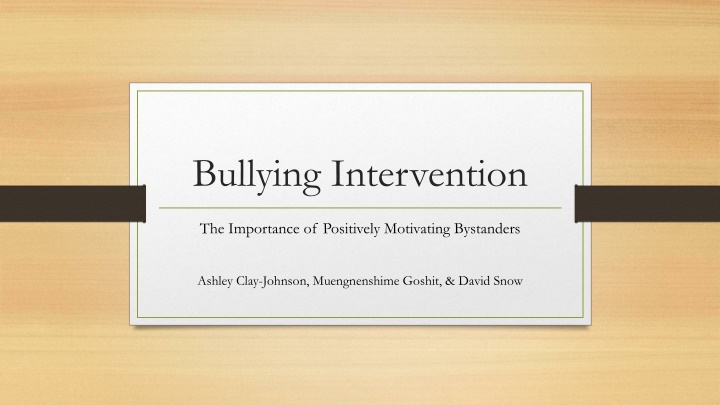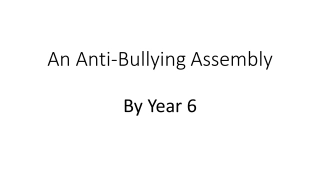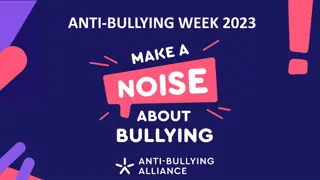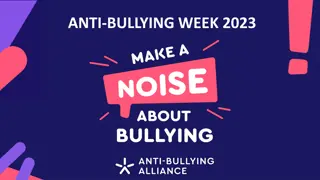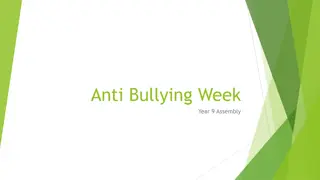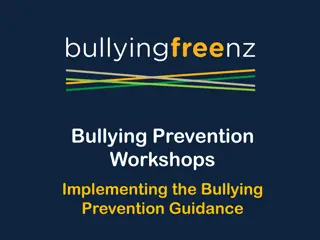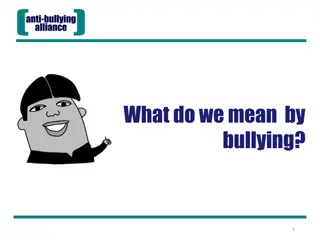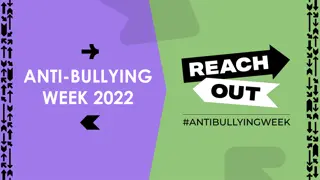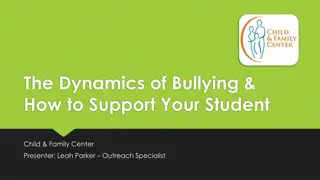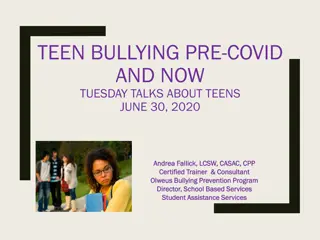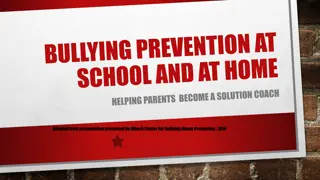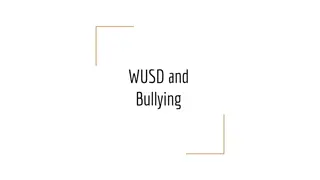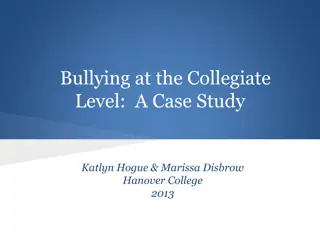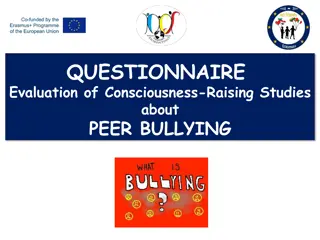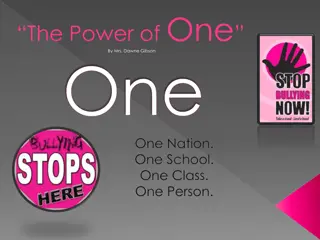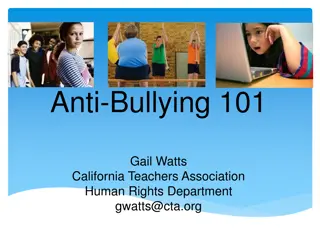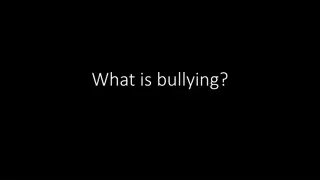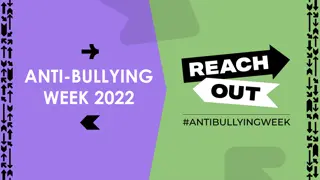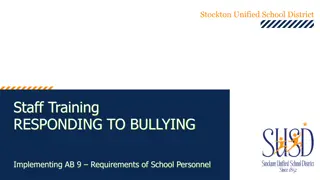The Importance of Bystanders in Bullying Intervention
Bullying intervention involves educating individuals to prevent or address bullying behavior. Bystanders play a crucial role in stopping bullying by intervening. Research shows that bystanders can effectively stop bullying when they decide to intervene. Utilizing bystanders and educating students about their roles can help create a safer environment and reduce bullying incidents.
Uploaded on Oct 01, 2024 | 5 Views
Download Presentation

Please find below an Image/Link to download the presentation.
The content on the website is provided AS IS for your information and personal use only. It may not be sold, licensed, or shared on other websites without obtaining consent from the author.If you encounter any issues during the download, it is possible that the publisher has removed the file from their server.
You are allowed to download the files provided on this website for personal or commercial use, subject to the condition that they are used lawfully. All files are the property of their respective owners.
The content on the website is provided AS IS for your information and personal use only. It may not be sold, licensed, or shared on other websites without obtaining consent from the author.
E N D
Presentation Transcript
Bullying Intervention The Importance of Positively Motivating Bystanders Ashley Clay-Johnson, Muengnenshime Goshit, & David Snow
What Is Bullying Intervention? Once bullying behavior is defined and identified, the question is what can we do about it? Bullying intervention is both: Programs meant to educate individuals on how to hinder or modify bullying behavior Individual strategies to directly address bulling behavior with the bully and the victim Utilizing bystanders to directly impact bullying behavior is one such intervention approach.
Why Are Bystanders So Important? Teachers, administrators and other school personnel often see themselves as the intervenors in bullying behavior Reality is that bullying behavior often goes unreported to teachers and school personnel Research shows that teachers intercede in only 15% to 18% of classroom bullying episodes
Why Are Bystanders So Important? Bystanders can play a powerful role in bullying intervention Bystanders provide bullies with an audience, which in turn incentivizes the bully to further threaten or embarrass the victim Research also shows that in 80% of observed bullying events, bystanders generally reinforced and encouraged the bullying behavior But when bystanders intervened in the bullying, the same research showed the bullying tended to stop quickly Other research showed that close to 50% of all bullying events stop when a bystander decides to intervene
Using Bystander Research for Effective Change How can we use that research to help stop bullying that occurs outside of the presence of teachers, administrators, and other school personnel? Teach our students how to identify bullying Educate students about the roles of negative bystanders, indifferent bystanders, and positive intervenors Develop standards of accountability for bystander behavior
Who Are Bystanders? The bystanders we are talking about are other children: They are the witnesses to bullying They usually fall into two camps: Negative bystanders that worsen the bullying situation Indifferent or do nothing bystanders
Negative Bystanders Negative bystanders make the bullying situation worse: Encourages the bullying through laughing, cheering, or making comments that encourage the bully; and May join in the bullying. Possible reasons for negative bystander behavior: May feel less accountable for their individual actions as part of a group and not as the primary instigator May dislike the victim or believe that the victim deserves such treatment
Indifferent Bystanders Indifferent bystanders decide to stay outside of the situation: Purposefully ignores or avoids the bullying Witnesses bullying, but decides not to take any action Witnesses bullying, but adopts an attitude of at least it s not me Indifferent bystanders often suffer negative consequences themselves, like guilt and anxiety over the bullying incidents
Reasons for Indifferent Bystander Behavior It s none of my business Fear of getting hurt or of retribution Feeling powerless to stop the bully Not wanting to draw attention to himself or herself Belief that telling adults won t help or will make things work Belief that adults rarely intercede in bullying Not liking the victim or believing that the victim deserves it They just don t know what to do
Reshaping Bystander Behavior Appeal to students sense of right and wrong when discussing bystander behavior Have students collectively develop standards of conduct: Define bullying, negative bystander conduct and indifferent bystander conduct Appeal to students sense of injustice by clearly identifying such behavior as wrong and not to be tolerated Place accountability on students to uphold the standards of conduct
Reshaping Bystander Behavior Once clear standards and expectations are set, teachers can educate students on ways to uphold the collectively-developed standards of conduct In particular, teachers should encourage bystanders to intervene in a positive way: Teach students what they can do to directly intervene discourage the bully; defend the victim; or redirecting the situation away from bullying. Or encourage bystanders to get help from other students or adults
Reshaping Bystander Behavior Students should be taught that it s never acceptable to encourage the bully or join in the bullying: If the bystander feels safe to do so, the bystander should assertively remind the bully of the standards of conduct for treating others and tell the bully to stop picking on the victim. If the bystander does not feel safe confronting the bully, the student should tell an adult about the bullying as soon as possible. Students need to understand that negative bystanders should and will be held accountable for their actions
Addressing Negative Bystander Behavior If you see a student acting as a negative bystander: Talk about the bullying incident and his/her bystander role with the student; Share your disappointment that the student had not attempted to intervene on the victim s behalf and discuss ways that he or she could have done so; and, Impose a disciplinary consequence for his/her negative bystander role.
Encouraging Bystander Behavior If you see a student intervening on behalf of a bullying victim: Recognize and praise the intervening student for his/her role; Discuss any concerns the intervening student may have, like fear of retribution from the bully; and, Reassure the intervening student that they can come to you with any further concerns or with any further bullying events.
Measuring Success It s difficult to measure success in bystander programs because teachers and other school personnel often don t witness the bullying events bystander programs are meant to address. But remember: Every intervening student increases the likelihood that a particular bullying event stops. Every student that buys into the standards of conduct and accountability means more one more agent of social justice and fairness possibly present to witness and intervene in bullying events.
